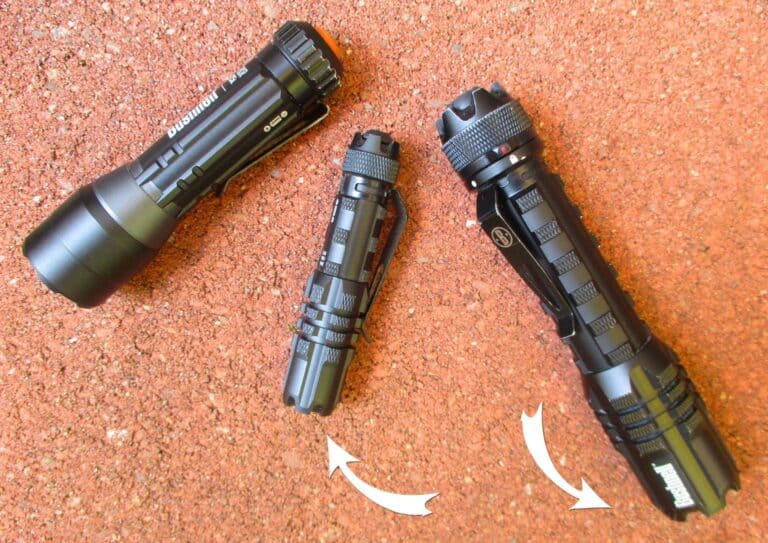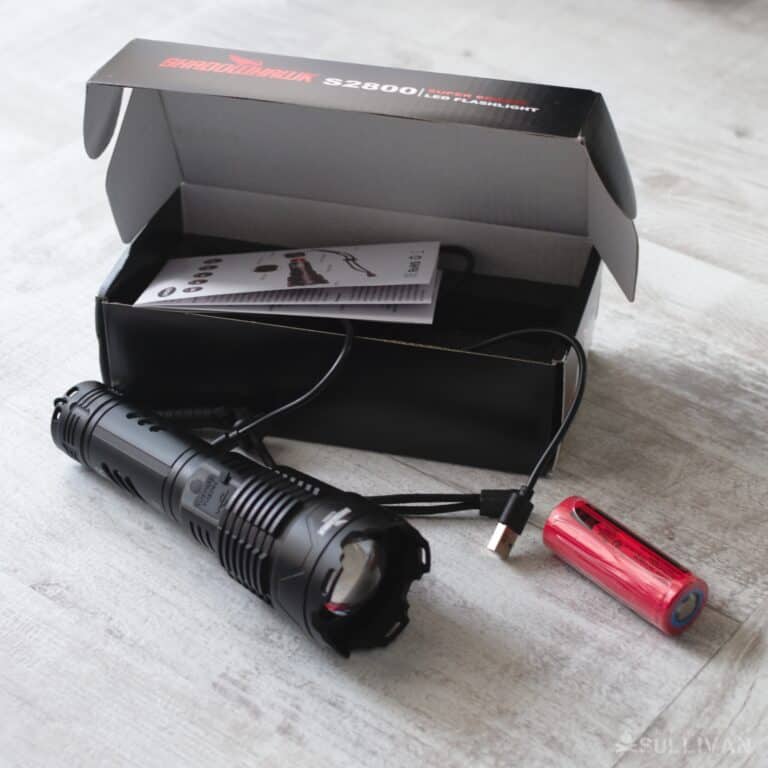More than any other tool (except perhaps a good pocket knife), a reliable, pocket-sized flashlight should be a constant companion for everyone. Modern flashlights often fall into the “tactical” category, being possessed as they are of exceptional brightness, superior ruggedness and long runtime, along with a variety of illumination modes to suit any application.

Quite a few tactical styled flashlights are found with sharpened prongs around the bezel and sometimes around the tailcap or switch assembly.
They definitely look aggressive, and instantly separate the tactical flashlight from its more mundane cousins, but here’s a question: Just what are these sharp edges on flashlights for?
The sharp edges typically seen around a flashlight’s bezel are called crenellations, and allow it to be used with greater efficacy as a striking tool, by focusing the force of a blow.
Keep reading to learn even more about these sharp end spiky flashlight accessories.
Crenellations Are Distinct from Glass-breakers and Knurling
Modern flashlights often look so sculpted, rakish and aggressive they are prone to appearing more like some kind of alien artifact or a modern artist’s interpretation of a torch then a ubiquitous personal lighting tool!
To further clarify what crenellations are, they are the series of chisel-shaped protrusions that ring the bezel and lens of a flashlight, and are sometimes also found ringing the tail cap. They get their name due to their similarity to the defensive architectural features found atop the battlements of a castle or fortress.
Other sharpened or distinctive protuberances that might be found on flashlights that are not crenellations include radiator fins, typically found along the back half of the head, knurling, which has a rough texture machine door molded into the body of the flashlight to improve grip, and glass-breakers, which are small conical or pyramid-shaped points that are designed to shatter automobile glass upon impact.
All of these devices are functional and helpful features of a flashlight, but they are distinct from crenellations, though glass breakers can also add a little more ‘oomph’ to a strike in hand-to-hand combat.

What Are Crenellations Good For?
As stated, crenellations give a flashlight greater effectiveness when used as a striking tool in close combat.
Now, if you are using any sturdy flashlight and strike someone with it, you can be fairly confident that you will deliver a more potent blow than you could with fist alone, seeing as how the typical tactical flashlight is made from extremely rigid glass-filled molded nylon or machined metal, but crenellations take this to a new level.
Crenellations typically have a slightly sharpened or, at least, beveled profile on the leading edge. This will drastically focus the force of a blow onto these small points, causing a good amount of pain and not insignificant soft tissue damage.
Crenellations are sometimes colloquially called “DNA collectors” for their propensity to bite small hunks out of people struck by them; if you are attacked and strike someone with your tactical flashlight, the police will easily be able to get a blood sample from beneath the sharpened teeth formed by the crenellations!
You can also make use of crenellations in a raking fashion by applying pressure with a flashlight, and then sharply pulling it in any direction. This technique can easily tear and lacerate skin, and is excruciatingly painful when performed on any surface of the body where bone is near the surface.
Additionally, crenellations can assist with pressure-point techniques, small joint manipulations, and other non-lethal self-defense moves by providing more grip or leverage on the target in addition to focusing the force use on a smaller area.
Perhaps best of all, for all the advantages they provide, crenellations are extremely low-profile ,and as far as this author has been able to find, legal absolutely anywhere throughout the United States.
No place that I am aware of bans by law flashlights from their premises and they can even ride with you on an airplane flight.
This makes crenellations an excellent sleeper tool for sensitive areas where other weapons might get you arrested, barred, or tossed out. Crenellations also afford the lens of the flashlight more protection, functioning as a substantial standoff from surfaces that would otherwise impact it.
While they might induce slight discomfort in typical use, crenellations around a tailcap switch also serve to protect the switch from inadvertent activation when in your pocket or luggage, ultimately saving you battery life, and possibly preventing a dead flashlight when you need it the most.
Disadvantages of Crenellations
It isn’t all good news with crenellations, however. A flashlight that has crenellations equipped will always be a little bit longer then it would be without them, a possible concern when space on your belt or in your pockets is always at a premium.
What’s more, crenellations can injure the user if they try to access the flashlight in a hurry, as these chisel-shaped protrusions do not care whom they draw blood from.
Having a beaky crenellation slip under one of your fingernails when you are trying to withdraw the flashlight from the pocket in a hurry is a uniquely painful experience you will not soon forget!
Crenellations are also notorious for snagging on loose thread, pocket hems and other fabric, and will readily chew through pocket linings in fairly short order. For an EDC flashlight that tears up your clothing so quickly you get comparatively little functionality in return.
Ultimately, crenellations are just another niche tool in a prepper’s toolbox, and will neither make nor break a flashlight so long as that flashlight is a good flashlight first and a striking tool second.
However, for preppers who are seasoned martial artists or grapplers, crenellations can provide a unique advantage in that they are on a go anywhere tool that will not raise any suspicions or alarms.
Conclusion
The sharp edges sometimes found on tactical flashlights, crenellations, are designed to assist the user with employing the flashlight as a striking tool by focusing force onto a smaller impact area and also raking or tearing at soft tissue.
Though not particularly effective compared to other weapons, as a low profile, go anywhere tool they do offer the clever prepper some advantages.
Do take care if employing them as an EDC option because these chisel-shaped prongs also have a way of tearing up your clothing just as readily as they do an attacker’s flesh.

Tom Marlowe practically grew up with a gun in his hand, and has held all kinds of jobs in the gun industry: range safety, sales, instruction and consulting, Tom has the experience to help civilian shooters figure out what will work best for them.

Good article . Only one disagreement. Your sentence “ though not particularly effective compared to other weapons “ leaves a lot of room for debate. Shine a powerful ( 300+ Lumens ) light n an opponents eyes and then employ the Light as a Yawara impact weapon . You have quite an effective self defense tool !